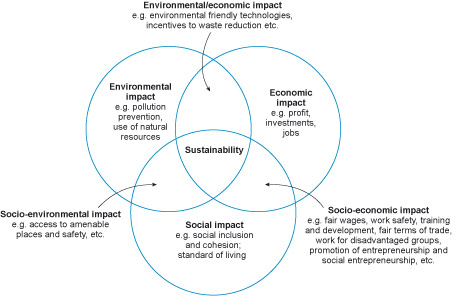The triple bottom line
The triple bottom line considers the different types of impact which can be produced, to varying extents, by business enterprises. They are:
- economic or financial impact
- environmental impact
- social impact.
The three dimensions identify the diverse but highly interconnected components of sustainability. Businesses are challenged to produce all three types of value if they want to be sustainable economically, environmentally and socially. For example, failure to protect natural resources creates barriers for social inclusion by destroying the conditions for accessing the life needs of people.
Failure to pay fair wages in order to accrue profits equally fosters marginalisation and social inequality. The figure below shows the intersections between areas of sustainability. This suggests that economic, environmental and social elements of business activities are not separable aspects when assessing the effects or societal impacts of entrepreneurship and innovation.
You have already read the Levi Strauss case study, which addresses the impacts generated by washing jeans, both for specific stakeholders and for the wider community.
The triple bottom line became popular following a series of corporate, unethical practices which destroyed social and environmental value in order to maximise profits. The idea of the triple bottom line is that businesses should pursue economic sustainability together with environmental and social sustainability. In particular the term tripple bottom line refers to three interlinked bottom lines that a sustainable enterprise pursues:
- Environmental bottom line: is measured through the so-called ‘planet account’, which identifies the environmental sustainability of the business.
- Economic bottom line: is typically measured by profit.
- Social bottom line: is accounted for by human wellbeing, or to what extent a business cares about people and societal needs.
Activity 10 The triple bottom line in entrepreneurial experiences
The Levi Strauss case study that you read earlier addresses the impacts generated by washing jeans, both for specific stakeholders and for the wider community. Now apply the triple bottom line framework to the case study.
As you re-read the case study, make notes on the following questions:
- What are the social impacts generated on specific stakeholders?
- What are the economic impacts generated on specific stakeholders?
- What are the impacts generated on the community as a whole?
Discussion
The case study identifies several examples of indicators that can be used to answer these questions and you will no doubt have identified many of them. Some examples under each of the three components of triple bottom line include:
- Economic bottom line: develop and implement sustainable strategies that allows the company to make profit. For example, the case study reveals how the company reduced their water or carbon impacts as a way of reducing costs and thereby retaining its reputation in the price–quality ratio. The positive publicity that comes with this also helps to increase sales and profit.
- Social bottom line: working with non-governmental organisations (NGOs) and key suppliers to support programs that improve workers’ lives; gone beyond labour compliance standards by publicly disclosing its manufacturing supplier locations.
- Environmental bottom line: set and achieve above the industry benchmark for waste as well as banning sandblasting. For example, a packaging supplier might offer a range of options based on the percentage of recycled material Levi Strauss prefer.

